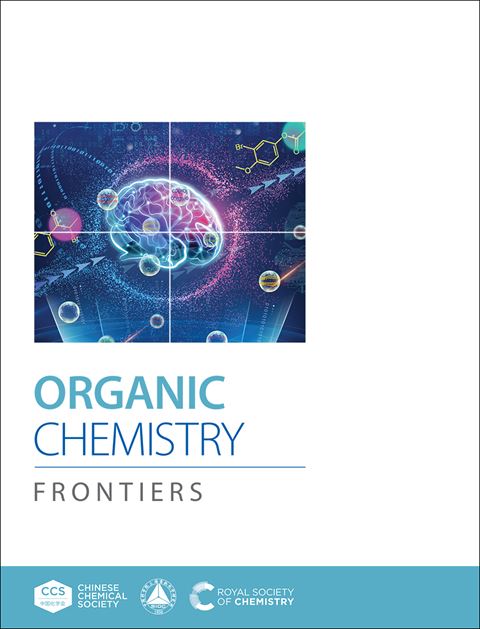Intramolecular Exciplex Formation Between Pyrene and Tetraazapyrene in Supramolecular Assemblies
IF 4.7
1区 化学
Q1 CHEMISTRY, ORGANIC
引用次数: 0
Abstract
Tetraazapyrene (TAP), a nitrogen-substituted analogue of pyrene, features a planar and electron-deficient π-conjugation system, and thus can act as a π-electron-acceptor. Despite its unique electronic properties, it remains underexplored due to synthetic challenges and limited derivatization methodologies. Herein, we report the first report of the selective cascade bromination of the TAP core in the presence of dibromoisocyanuric acid, affording 4,9-dibromo-TAP as a key intermediate. This precursor was subsequently employed to construct a novel pyrene-TAP-pyrene trimer (1), in which a central TAP core is flanked by two pyrene units via phosphodiester linkages. Similar to its all-pyrene-based analog in aqueous medium, this trimer undergoes temperature-triggered self-assembly via inter- and intramolecular non-covalent interactions, leading to the formation of supramolecular polymers featured with a donor-acceptor-donor architecture. Upon self-assembly, trimer 1 exhibits distinct optical responses, including enhanced monomeric pyrene fluorescence and unique exciplex emission. These phenomena are attributed to enhanced electronic interactions between pyrene and TAP cores facilitated by their close spatial arrangement in the resulting nanostructures. Our findings demonstrate the reversible and tunable nature of self-assembled nanostructures, highlighting their potential in the development of stimuli-responsive materials.超分子组装中芘和四氮芘分子内杂络合物的形成
四氮芘(TAP)是芘的氮取代类似物,具有平面的亏电子π共轭体系,可以作为π电子受体。尽管它具有独特的电子特性,但由于合成方面的挑战和衍生化方法的限制,它仍未得到充分开发。在此,我们首次报道了在二溴异氰尿酸存在下TAP核心选择性级联溴化,提供4,9-二溴-TAP作为关键中间体。该前体随后被用于构建新的芘-TAP-芘三聚体(1),其中中央TAP核心通过磷酸二酯键连接两个芘单元。与水介质中基于芘的类似物类似,这种三聚体通过分子间和分子内的非共价相互作用经历温度触发的自组装,从而形成具有供体-受体-供体结构的超分子聚合物。自组装后,三聚体1表现出独特的光学响应,包括增强的单体芘荧光和独特的外络合物发射。这些现象归因于芘和TAP核之间的电子相互作用增强,这是由于它们在纳米结构中的紧密空间排列所促进的。我们的发现证明了自组装纳米结构的可逆性和可调性,突出了它们在刺激响应材料开发中的潜力。
本文章由计算机程序翻译,如有差异,请以英文原文为准。
求助全文
约1分钟内获得全文
求助全文
来源期刊

Organic Chemistry Frontiers
CHEMISTRY, ORGANIC-
CiteScore
7.90
自引率
11.10%
发文量
686
审稿时长
1 months
期刊介绍:
Organic Chemistry Frontiers is an esteemed journal that publishes high-quality research across the field of organic chemistry. It places a significant emphasis on studies that contribute substantially to the field by introducing new or significantly improved protocols and methodologies. The journal covers a wide array of topics which include, but are not limited to, organic synthesis, the development of synthetic methodologies, catalysis, natural products, functional organic materials, supramolecular and macromolecular chemistry, as well as physical and computational organic chemistry.
 求助内容:
求助内容: 应助结果提醒方式:
应助结果提醒方式:


